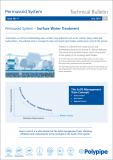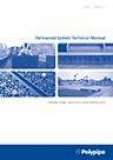 pdf (305.75 KB)
pdf (305.75 KB)
 pdf (305.75 KB)
pdf (305.75 KB)
 pdf (2.92 MB)
pdf (2.92 MB)
Permavoid Technical Bulletin Issue 4 -...
 pdf (7.13 MB)
pdf (7.13 MB)
The Permaceptor functions as a combined run-off collection, silt/oil interceptor and treatment feature within the Permavoid system. It is designed to be used with conventional road/yard gullies and is ideally laid with zero gradient to prevent the development of lateral velocities. Its initial function is to ‘still’ sheet run-off from each sub-catchment and to encourage silt deposition. The outlet discharges via a weir and baffle component that separates oils and prevents the effluent and silt from reaching the rest of the drainage system.
Permaceptor is used for stormwater collection, interception and the treatment of associated pollutants. The system comprises Permavoid and Biomat units located to collect surface water run-off from sub-catchments within impervious or pervious pavements via Polypipe Ridgigully and Midigully. Permaceptor is suitable for a range of applications including residential, industrial estates, car parks and basements.
The structural load bearing capacity of the Permavoid units has been tested in accordance with the following European Standard: BS 7533-13:2009. The system’s structural design life expectancy, based upon creep test data (tested according to CIRIA guidelines) is as follows; for lightly loaded areas such as car parks a design life of 50 years is achievable. For areas with prolonged HGV loading a typical design life may only be 25 years, depending on the design of the pavement surfacing and structural layers over the tank.
All calculations for Permaceptor units are based upon site-specific load cases, construction types and thickness, soil cover and ground conditions and the suitability must therefore be approved for each project.

 pdf (305.75 KB)
pdf (305.75 KB)
 pdf (2.92 MB)
pdf (2.92 MB)
 pdf (7.13 MB)
pdf (7.13 MB)